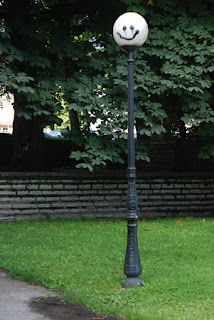The Modernist notion of ‘Form Follows Function’ from the turn of the 19th century, but much vaunted in the 1950s and 1960s, was taken to extremes and allowed for a block concrete world where detail and creativity were considered extravagant ‘extras’. I am a very big fan of simple design, and new creative thinking can take detail to a further level than the fundamental starkness popular in the times of fifty years ago. Often we take the results utterly for granted, but on the occasions when we do take notice the effect can be deeply exhilarating. Thinking ‘outside the box’ occurs across the world and using materials of different price and robustness.
 |
| Cleveden retracting bollard - photo taken by Joanne Lloyd |
Since this blog is about bollards, I will start with a form of bollard that I have loved ever since first meeting one in Brighton just outside the Fire Station. Walking down the street, suddenly this large and solid blob in the pavement started to disappear into the ground! I stood rooted to the spot wondering what was going on, until I realised that standing there had a pretty low life-expectancy if I stayed put any longer. I stepped back as the doors opened and the red engines roared out into the street and off in loud pursuit of the call-out. Often times we will see bollards that collapse on a hinge. These are low-tech and require little maintenance, but woe the tyre that gets near to them. The electric retraction bollard is a piece of beauty and smooth operation. The photograph was taken by my friend Joanne Lloyd of bollards at a Marina just outside Bristol. This bollard automatically retracts when approached from one side but not the other. The Fire Station bollard has to have been activated remotely, since no vehicle was in sight at the time it disappeared....
 |
| Drainage in patterned paving, Lisbon |
Drains. Without drains in our wet climate we would always be paddling or slipping on ice covered pools. In dry climates the rains can come heavily and often the drains need to be larger to accommodate the high if less frequent level of runoff. Drains in public open space come in all manner of shapes and sizes and there can be various techniques employed to manage how intrusive they can be. I love the simplicity of form of the drain in a square in central Lisbon, where the texture of the small unit paving and the holes in the drain echo one another and the alignment of the drain is utterly true to the design of the paving. Never easy to achieve, but very effective
 |
| Pedestrian crossing, Helsinki |
when done well. In a similar vein pedestrian crossings don’t always have to be done in paint, they can also be incorporated within the design. Problems arise if roadworks take place underneath the spot, tarmac infill can cause a moth-eaten effect…..
 |
| Cycle path, Stockholm |
We have a world that is dominated by signage and so much so that most of us have developed a disturbing knack of missing some completely because we have gone into overload. Advertisers are now trying to hit us with varying levels of “You what!” advertising, a form I have always called frictional because it creates an effective that draws attention in spite of ourselves. Landscape designers are now using new creative techniques to enclose the signage users want to know about in the detail of their schemes. Two special forms are shown here, an embossed metal outline of a bicycle showing which is the cycle lane on a complex of paths from Stockholm, Sweden and a surprising little disabled sign
 |
| Disabled sign, Montecristi, Ecuador |
|
from Montecristi in Ecuador made from blue marble sitting in concrete. Simple and effective methods of realigning our response to the clutter of signs.
 |
| Hanging basket, Tortola Botanic Gardens |
My final comment relates to a special piece of low-tech design I saw in Tortola Botanic Gardens. The ingenious use of common materials is a major feature in the Caribbean landscape and tyres crop up as planting pots for date palms, boundary fencing and also as this very attractive hanging basket. The same day that we saw this we were treated to a steel band whose extra piece of percussion came from brake discs!
Function and design are inter-twined concepts, but this doesn’t actually imply any rules to be adhered to at all. So long as they work, of course.
 The next photo is part of a series that I used in a blog post last year, but it is such a remarkable piece of craftsmanship and warm sense of humour that I have to use another from the set. Kaffe Fassett’s murals for the Highland Stoneware company utilised broken shards from some of their very popular designs. The sheep design just visible adorns a well-loved vase of mine as well as this rock in the bay at Lochinver.
The next photo is part of a series that I used in a blog post last year, but it is such a remarkable piece of craftsmanship and warm sense of humour that I have to use another from the set. Kaffe Fassett’s murals for the Highland Stoneware company utilised broken shards from some of their very popular designs. The sheep design just visible adorns a well-loved vase of mine as well as this rock in the bay at Lochinver.



























